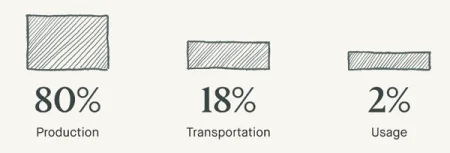Inside reMarkable
Being honest about emissions
Here, we've gathered information about the environmental impact of reMarkable 2 and the key contributing factors to its CO2 footprint from the production and distribution process. It goes without saying that we're continuously working on improving these results.

The emissions information presented here is a result of mapping done by sustainability consultancy firm CEMAsys in 2022, using the GHG Protocol and ISO 14040:2006 as points of reference. These are both common global standards, which we’ve used with a tailored approach to better fit the purpose of the exercise.
Emissions data is often presented as CO2 equivalents, which just refers to the amount of carbon released into the atmosphere, or the "equivalent" amount of another substance. It makes it easier to compare emissions from different sources and identify opportunities for change.
The carbon footprint of each reMarkable 2 is 53 kg of CO2e. To put that in context, a 10th-generation Apple iPad generates 72 kg of CO2e.
Of reMarkable 2’s carbon footprint, 80 percent of the emissions stem from production, while the next biggest source is transport at 18 percent. Looking more closely at production emissions, we know of the individual reMarkable 2 components that the mainboard PCB is the main contributor, accounting for 29.9 kg of CO2e.

This film shows part of the production process involving the printed circuit board (PCB) for reMarkable 2, its electronic brain.
At the foot of this article you’ll find updated links to our complete carbon reports for 2021, 2022, and 2023. These include more detail related to the overall breakdown of our emissions by scope, for example scope 1 is direct emissions caused by things owned and operated by reMarkable, while other indirect emissions are further divided into scope 2 and 3 upstream (production) and downstream (product use) emissions.
It’s difficult to say that we’re part of the emissions problem, but admitting it is the first step toward fixing it. The reason we believe so much in transparency is because it’s a key driver for positive change. If people don’t have all the information they need before purchasing something, then they can’t make an informed decision.
You can read our Carbon Report 2021 - 2023 here.


